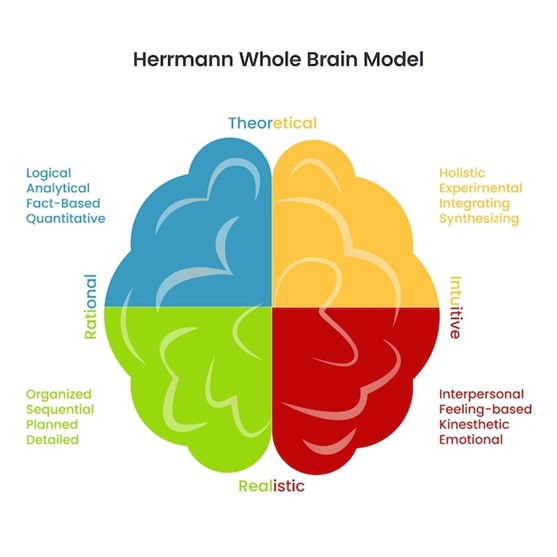For a company to remain competitive and strategic in today’s rapidly changing environment, effective decision-making is essential. That’s where the power of whole brain thinking comes in. By leveraging both the analytical and creative aspects of our minds, we can make informed decisions that drive growth and success. This article explores the importance of whole brain thinking in decision-making and how organizations can harness its power to make better choices. Get ready to unlock your full decision-making potential and propel your business forward.
Understanding Whole Brain Thinking
Whole brain thinking is a powerful approach that recognizes and harnesses the different thinking styles and preferences of individuals within an organization. It is based on the idea that each person has a unique cognitive approach to assimilating information and solving problems. These thinking styles can be broadly categorized into four quadrants: analytical, practical, relational, and experimental.
The analytical quadrant is characterized by logical and quantitative thinking. Individuals with a preference for this style excel in analyzing data, facts, and figures. They approach problem-solving in a structured and step-by-step manner. On the other hand, the practical quadrant emphasizes practicality, detail orientation, and organization. People who lean towards this style follow instructions and procedures meticulously, focusing on the practical aspects of a situation.
The relational quadrant is associated with emotional intelligence and interpersonal skills. Individuals with a preference for this style thrive in collaborative settings, valuing teamwork and communication. They excel in understanding others’ emotions and building relationships. Lastly, the experimental quadrant is marked by a preference for holistic and intuitive thinking. People with this thinking style are often creative and innovative, exploring new ideas and approaches.
The Impact of Whole Brain Thinking on Decision Making
By embracing whole brain thinking, organizations can unlock the full potential of their workforce and make more informed and effective decisions. Here’s how whole brain thinking can positively impact competitive decision-making:
1. Diverse Perspectives and Innovation
When decision makers consider the different thinking styles within their team, they open doors to diverse perspectives and innovative ideas. By encouraging individuals to contribute from their preferred quadrants, organizations can tap into a wealth of creativity and varied approaches to problem-solving. This diversity of thought leads to more innovative and robust decision-making processes.
2. Comprehensive Analysis
Whole brain thinking ensures that decision makers consider all angles and dimensions of a problem or opportunity. By incorporating analytical, practical, relational, and experimental perspectives, organizations can conduct comprehensive analyses of the factors influencing a decision. This holistic approach reduces the risk of overlooking critical information and leads to more well-rounded and informed decisions.
3. Improved Communication and Collaboration
Understanding the thinking styles of team members facilitates better communication and collaboration. When individuals are aware of their own preferences and those of their colleagues, they can adapt their communication styles to ensure effective information sharing and collaboration. This shared understanding enhances teamwork, reduces misunderstandings, and promotes a more cohesive decision-making process.
4. Enhanced Problem-Solving Abilities
Whole brain thinking equips individuals and teams with a broader range of problem-solving abilities. By stretching outside their preferred thinking styles, individuals can develop new skills and approaches to tackle challenges. This flexibility and adaptability in problem-solving enable organizations to navigate complex and uncertain situations more effectively.
5. Strategic Alignment
Strategic decision-making requires alignment across different functions and departments within an organization. Whole brain thinking facilitates this alignment by fostering an appreciation for different thinking styles and preferences. When decision makers recognize and value the contributions of each quadrant, they can build strategic teams that cover a wide range of perspectives. This strategic alignment leads to more cohesive and effective decision-making at all levels of the organization.
Implementing Whole Brain Thinking in Competitive Decision-Making Processes
Now that we understand the power of whole brain thinking, let’s explore how organizations can implement this approach in their decision-making processes:
1. Assessing Thinking Preferences
To begin the implementation of whole brain thinking, organizations can assess the thinking preferences of their employees. Various tools, such as the Herrmann Brain Dominance Instrument (HBDI), can provide valuable insights into individuals’ thinking styles and preferences. These assessments help create a baseline understanding of the thinking diversity within the organization.
2. Building Strategic Teams
Based on the assessment results, organizations can build strategic teams that encompass a range of thinking styles. By pairing individuals with complementary thinking preferences, organizations can leverage the strengths of each quadrant and ensure a well-rounded approach to decision making. For example, a team might benefit from pairing an analytical thinker with a relational thinker to bring together quantitative analysis and interpersonal skills.
3. Facilitating Open Communication
Creating an environment that encourages open communication and respect for diverse thinking styles is essential. Decision makers should foster a safe space where individuals feel comfortable expressing their ideas and perspectives. This open communication allows for the sharing of diverse viewpoints, leading to richer discussions and better decision outcomes.
4. Training and Development
Organizations can support the development of whole brain thinking skills through training and development programs. These programs can help individuals understand their own thinking preferences, appreciate the strengths of other quadrants, and learn how to stretch outside their comfort zones when necessary. By providing ongoing training and support, organizations can nurture a culture of whole brain thinking.
5. Iterative Decision-Making Processes
Whole brain thinking aligns well with iterative decision-making processes. Instead of relying solely on one thinking style, decision makers can adopt an iterative approach that incorporates input from each quadrant. This iterative process allows for continuous refinement and improvement of decisions, leveraging the diverse perspectives and insights of the team.
Conclusion
Whole brain thinking is a powerful approach that enhances competitive and strategic decision-making by leveraging the full potential of the human brain. By embracing the diverse thinking styles within an organization, decision makers can tap into innovative ideas, conduct comprehensive analyses, improve communication and collaboration, enhance problem-solving abilities, and achieve strategic alignment. Implementing whole brain thinking requires assessing thinking preferences, building strategic teams, facilitating open communication, providing training and development, and adopting iterative decision-making processes. By embracing whole brain thinking, organizations can make more informed and effective decisions, giving them a competitive edge in today’s dynamic business landscape.
Unlock your full potential with whole brain thinking. Contact us. Take the first step towards enhanced, competitive decision-making and strategic alignment. Contact WHS and Training Compliance solutions for your HBDI Assessment and unlock limitless possibilities today!












